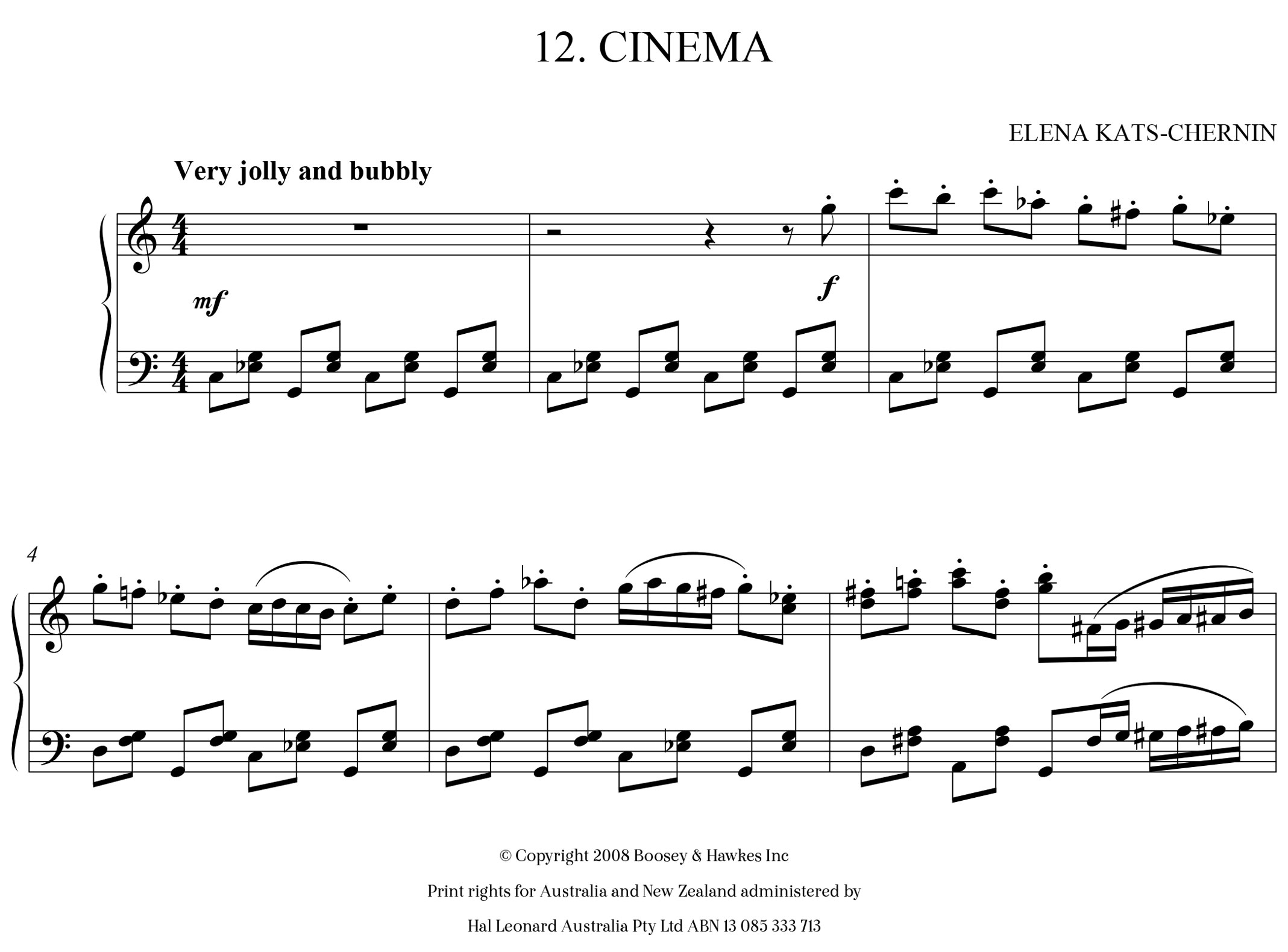There’s something very exciting about discovering and working with repertoire that you know students are going to engage with, including finding composers and works that are lesser-known to Australian audiences. In amongst the 1000 volumes (and still counting!) of solo repertoire that I’ve reviewed in the past year, there were a few collections that genuinely stood out in terms of the quality and interest in the writing, and pedagogical strengths. I could go on for some time, such is the depth of great music out there. But for starters, here are a few discoveries to share!
[accordion]
[item title=”Jazz – Click here”]
I’m sure we all have our favourite jazz/popular genre pieces, perhaps including works of Christopher Norton and Kerin Bailey, who are such well-established favourites of Australian teachers. German composer Manfred Schmitz’s work may or may not be familiar to you — a few of his ‘Jazz Inventions’ appeared in AMEB volumes in Series 15, and there are a handful of his jazz inspired pieces in the ‘Getting To’ series. I’m an unabashed admirer of his work.

His volume of 25 Jazz Inventions (Deutsche Verlag für Musik) are obviously referencing Bach’s two-part inventions, but presented using Schmitz’s more contemporary sounding themes. As you would expect in inventions, these works are excellent for cultivating independence and control between the hands, featuring answering phrases and imitation. The various voice lines are able to be followed clearly, which allows a young player to really be able to concentrate on and bring out the answering phrases, and articulations. For young players, the writing fits very nicely under the hand, and is a wonderful introduction to the listening of different lines and parts. The volume’s works range from approximately Grade 2 to Grade 5 (AMEB), and might be useful as precursors before actual Bach inventions. If you have students who are more interested in popular repertoire, this would be a great way of developing classical control techniques, in a jazzy, modern-sounding disguise!

Manfred Schmitz has also produced a ‘Mini’ series of books, including the titles Mini Jazz, Mini Rock and Mini Tango. Covering a general blues/jazz style, with (classic) Rock’n’roll, and Tango inspired pieces, the pieces range from a couple of lines to a few pages in length. My favourite of the volumes would be Mini Tango, which contains both solos and a few duets, ranging from Preliminary to about Grade 5. The earliest pieces in the collection feature a lot of answering phrases, and like the Jazz Inventions, would be excellent little mini studies in articulations between the hands. These pieces don’t work without attention to these details, so play them without to your students to demonstrate what a difference those details can make! The whole book is worth exploring, but check out Tango for Two (approximately Grade 3) and Tango Aurora (approximately Grade 4) if you’re running short on time!

Another interesting German composer writing in a jazz style is Mike Schoenmehl. His diverse career has seen him active as a jazz pianist, lecturer at universities, and editor of popular music for the German publishers Schott. You may have previously seen his piece Sherlock Holmes in the Preliminary Piano for Leisure syllabus. His collection Piano Studies in Pop (Schott) is a standout volume, containing 17 engaging intermediate level pieces. So far, my students have particularly enjoyed Melancholy Reflections, Train Journey, and Disco Visit (all mid–intermediate levels).

American musician Jeremy Siskind is a rising star in the jazz piano world. Now a Professor of Piano at Western Michigan University, his 2012 debut at Carnegie Hall featured Debussy’s Etudes in the first half, and jazz improvisations in the second half. His book Jazz Etude Inspirations (Hal Leonard) rates as one of the best pedagogical jazz piano volumes I’ve seen. Writing pieces in the style of jazz greats including Duke Ellington, Chick Corea, Herbie Hancock, Oscar Peterson, and Count Basie, Siskind also provides recommended listening for each of the musicians he’s drawn inspiration from. Brief backgrounds to the work and some general teaching points are helpful to contextualise. As a volume that helps students develop an appreciation and stylistic understanding of some of the jazz greats, as opposed to learning something that’s ‘just jazzy’, you can’t go past this score. My pick of the pieces here is Pineapple Woman, directly inspired by Herbie Hancock’s funky Watermelon Man (and also Cantaloupe Island in my ears.) It’s approximately Grade 4–5 AMEB.

[/item]
[item title=”Moving away from jazz…but still popular – Click here”]
[title maintitle=”Moving away from jazz” subtitle=”..but still popular”]

Moving away from jazz, but still in the popular realm, the compositions of Ludovico Einaudi are gathering momentum and developing awareness in the piano teaching world. This Italian pianist / composer is arguably best known (outside of Italy) for his recent work on the soundtrack of the French film The Intouchables. His works have several million views on YouTube, testifying to his music’s general appeal — an expressive popular style combined with minimalism. Teenagers tend to love the repeated patterns and the flowing style, which makes them sound good without extensive note learning. You can find his most appealing Primavera in the excellent compilation volume River Flows in You (Hal Leonard). Einaudi’s ’best of’ volume (Ricordi, approximately Grades 2–7) contains some of his most popular piano works, including I giorni [The Days] (approximately Grade 5); well worth exploring with student not only for performance, but from a compositional point of view. How Einaudi is able to extend ideas, with subtle changes, can provide valuable understandings in harmony, structure, improvisation, and interpretation. It’s also important to note that Einaudi’s work does tend to ask for large stretches, so is generally better suited to teenagers and adults.

[/item]
[item title=”Classically orientated – Click here”]
[title maintitle=”Classically orientated” subtitle=””]
Now looking towards more classically oriented collections, I have always wished that there were more works written by the so-called ‘impressionist’ composers, suited to earlier grade level players. At a pinch, there are a handful of pieces prior to and around the Grade 5 level, but mostly it’s in those late intermediate and advanced levels that we start to encounter these sound worlds, colours, and techniques. One composer filling this void is American composer Jennifer Linn, with her volume Les Petites Impressions (Hal Leonard), containing works from approximately a Grade 3–6 level. La marée de soir [Evening Tide] is a personal highlight: a charming piece that could be technically tackled by a solid Grade 3 level student, but it requires some interpretative thought, and may generally sit more meaningfully with a Grade 4 level player. It looks (and sounds) much more difficult on the page than it actually is, with lots of repeating hand positions moving through the octaves. With a little analysis, students should zoom through the note learning aspect of this piece. Pedal is an important aspect of this work, but is not overly challenging to execute well in this piece. Helpfully, the volume also includes a glossary of the French musical terms used, so there are no excuses in not understanding terms!

[/item]
[item title=”For the youngest players – Click here”]
[title maintitle=”For the youngest players” subtitle=””]
 For the youngest players, there were a number of interesting standout volumes. Carol Klose’s Coral Reef Suite (Hal Leonard) contains classical contemporary sounding, atmospheric pieces, all at around a Preliminary level. All of the pieces in the volume have clear pedagogical motives, but are also strikingly artistic for the level. Much of the time it seems to me as if to be experimenting with sound and physical gestures, at times almost improvisatory in nature. The Angelfish Arabesque is a very clever little piece, helping to develop the technique of passing smoothly between the hands, and a feel and ear for evenness in spacing. The same notes are played in different registers (useful for reinforcing the finding and placement), and thus there is regular hand crossing, using only fingers 2 and 3 in both hands.
For the youngest players, there were a number of interesting standout volumes. Carol Klose’s Coral Reef Suite (Hal Leonard) contains classical contemporary sounding, atmospheric pieces, all at around a Preliminary level. All of the pieces in the volume have clear pedagogical motives, but are also strikingly artistic for the level. Much of the time it seems to me as if to be experimenting with sound and physical gestures, at times almost improvisatory in nature. The Angelfish Arabesque is a very clever little piece, helping to develop the technique of passing smoothly between the hands, and a feel and ear for evenness in spacing. The same notes are played in different registers (useful for reinforcing the finding and placement), and thus there is regular hand crossing, using only fingers 2 and 3 in both hands.
Like the Coral Reef Suite, Mona Reinjo Circus Suite (also Hal Leonard) is another similarly striking volume for Preliminary level players, but this time with pieces of a general circus theme.
[title maintitle=”William Gillock” subtitle=”Revered American pedagogical keyboard composer”]
William Gillock is a revered American pedagogical keyboard composer, but his general awareness is still growing in Australia. His work can always be safely trusted to be of a quality craft and musicianship. His compositions — particularly for young elementary and intermediate level players — often make the most of the full keyboard, and use the piano in such a way as to not sound like a simple piece. There are many wonderful Gillock volumes available; for pieces in the Preliminary to about Grade 2 range, try William Gillock Classic Repertoire – Elementary (Willis Music Company). There are numerous character pieces, with Little Flower Girl of Paris particularly proving popular with my own students. Charming to the learners, it is also a work that can be used to develop coordination control of different touches between the hands, and features a left-hand melody.
[/item]
[item title=”Australian Repertoire – Click here “]
[title maintitle=”Australian Repertoire ” subtitle=””]
In Australian repertoire, it’s hard to go past Elena Kats-Chernin’s collection Twelve One-Page Piano Pieces (Boosey and Hawkes). Featuring short (but rarely actually fitting on one page!) pieces, there are many excellent pieces, including the spirited Cinema (which is in the new AMEB Series 17 Grade 6 volume), and Russian Waltz (approximately Grade 4) which is based upon the popular Russian Rag (also in the A.Mus.A syllabus).

In Australia, the AMEB syllabus — particularly the graded exam publications — are dominant, and it’s been an exciting year with Series 17 coming into play. Editor David Lockett has done an amazing job of putting the series together, with genuinely musical selections that should appeal to both young and older learners.
[/item]
[/accordion]
Speaking of examination systems (and remaining within the ‘Commonwealth’!), some teachers may be aware of the Royal Conservatory Music Examinations system, in Canada. It’s also used increasingly in the US. The Celebrations Series (Frederick Harris Music) contains 12 graded volumes of repertoire (starting with two books covering the mid-method book track/early preparatory levels). There are separate ‘Repertoire’ and ‘Piano Etude’ books, and are a generally superb collection of materials, including many composers that are not commonly heard in Australia. A new series (2015) was released in March this year, replacing the similarly excellent 2008 series.
Happy exploring!
[infobox maintitle=”You may also be interested in” subtitle=”The Busy Teachers’ Guide To Repertoire: Duets and Trios” bg=”red” color=”black” opacity=”off” space=”30″ link=”http://thepianoteacher.com.au/articles/the-busy-teachers-guide-to-repertoire-duets-and-trios/”]
